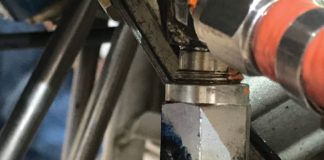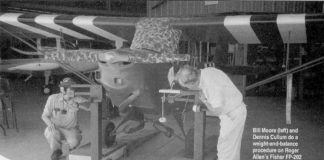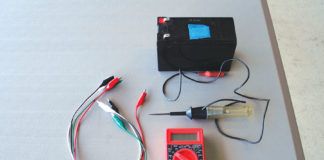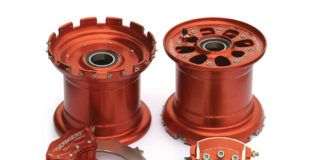Builders, even first-timers, want to do something to make their airplanes really theirs. For most of us that means a different panel or a paint scheme unlike anyone elses on the field. Paul Lipps of Santa Maria, California, has done just the opposite with his plane. I might never paint it, he said, too many experiments to do.
At first look, though, most people dont notice the finish on his Lancair 320. Some first spot the Piper Cub logo on the tail, but everyone, sooner or later, zeroes in on the prop. While the logo is simply anachronistic, the prop leading the way is decidedly futuristic.
Paul is a lot like his airplane in that hes a bit of an anachronism with an eye toward the future. Hes a non-degreed engineer who helped design radar systems for the fi rst ICBMs. After retiring with that background in electrical engineering, he changed course and went after propeller design. Now, you might be asking yourself, With all the technology, computers and Ph.D.s at the big prop manufacturers, how could an amateur come up with something so different and expect it to work? Pauls answer to that is insight.
No Brag, Just Fact
Letting your eye wander a bit closer to the fuselage you spot a 24-inch-long pitot tube. While it may be obvious that the pitot inlet has to be in undisturbed air to get a good reading, the purpose of the side holes, and the tape aft of them, is not quite so apparent.
Pauls experimentation showed that the typical static port didn’t yield a pressure that matched the pressure normally accessed by the altimeter and VSI. Adding a bit of tape behind the flow caused that match to occur. A minor improvement, yes, but hes an experimenter. Paul went on to point out that the position of the tape matters. Some systems achieve a match with the tape in front, and some are corrected with the tape to the rear, he said. You have to experiment.
Other Curious Details
Going around to the front of the canopy we see an odd round hole. Thats a high-pressure zone in flight, so a small hole is all thats needed to supply copious amounts of cool air to the cockpit. Its also sufficient for the muffin fan when on the ground. As to being a potential rain inlet, Paul says he keeps the airplane in the hangar when it rains. It would, however, be a simple task to install a valve, so this seems quite plausible.
Now, unintentional bias is the sort of thing that can cause a great deal of embarrassment when making claims of significant improvement. To counter the tendency to push forward on the stick when checking for speed improvements Paul mounted a bubble level on the canopy edge.
Aerodynamics Are His Thing
His testing revealed some surprises. A bus with rounded corners is a pretty good shape, while a truck of the same size, but with square edges, is not. You have to love it when a guy takes nothing for granted and demands proof.
First Among Equals
Then there’s the issue of horsepower. Again, the experimenter comes out. Paul placed his airplane on two scales, leveled it, tied the tail to the building and started the engine. With a friend to take a reading of the scales, he ran the engine up to several speeds to find where the load on one wheel was the greatest. Multiply the distance from the axis of the prop to the centerline of the tire times the load on the scale and you get torque. Plug that into a simple formula: Horsepower = (torque x rpm)/5252, and you get the horsepower of the engine.
If you care to learn more about the relation between torque and horsepower, there’s a very readable dissertation on the web at
http://vettenet.org/torquehp.html.Now that we’ve involved the front, you notice that the gap between the spinner and the prop is tiny. Paul asks, Why pressurize the cowl and then let that air blow forward out around the spinner? Keeping the air all going the right direction also allows smaller inlets on the front of the cowl, hence allowing lower drag as well.
To get the air across the cylinders you have to create a pressure differential above and below the engine. To keep that P at its peak means not only sealing the upper half, but the lower half as well. Paul pointed out that a large clearance between the lower cowl and the exhaust pipe or around a landing light means that air is flowing into the cowl through that gap. Result? The lower cowl is not at the lowest possible pressure. That bumped transition from the spinner to the upper cowl? Paul describes it as something known as the Coanda eff ect. This effect is what causes air to attach to, and then accelerate around a discontinuity. Its been employed on state-of-the-art aircraft such as the exhaust nozzles of the F-117.
But something else looks odd…the upper cowl inlets are very close to the centerline of the spinner. Most other aircraft have the inlets positioned at the outer edge of the cowl. This is, per Pauls experimentation, due to the poor shape of the inner 25% of the prop. The root area of most props is, in effect, a flat disk in front of the engine. My prop design uses all the prop for propulsion, right down to the root.
Last But Not Least
The exotic shape along the leading and trailing edges is the result of his calculations in 1-inch increments out to the tip. It has exactly the same thrust load at any point, he said.
Almost as startling as the shape is the tip flexibility. Try deflecting a production prop with just a finger and thumb and you’ll get nowhere; do it with Pauls and you’ll get a surprise.
Poul Anderson, the sci-fi writer, once said, No problem is so difficult that with a great deal of thought and effort it cannot be made impossible. Paul Lipps seems to have understood that this
bon mot is filled with more truth than we may care to admit. But where others miss the point and apply more of the same old thought and effort, Paul looks for insight. After all, isn’t that how David was able to make his name versus Goliath?




